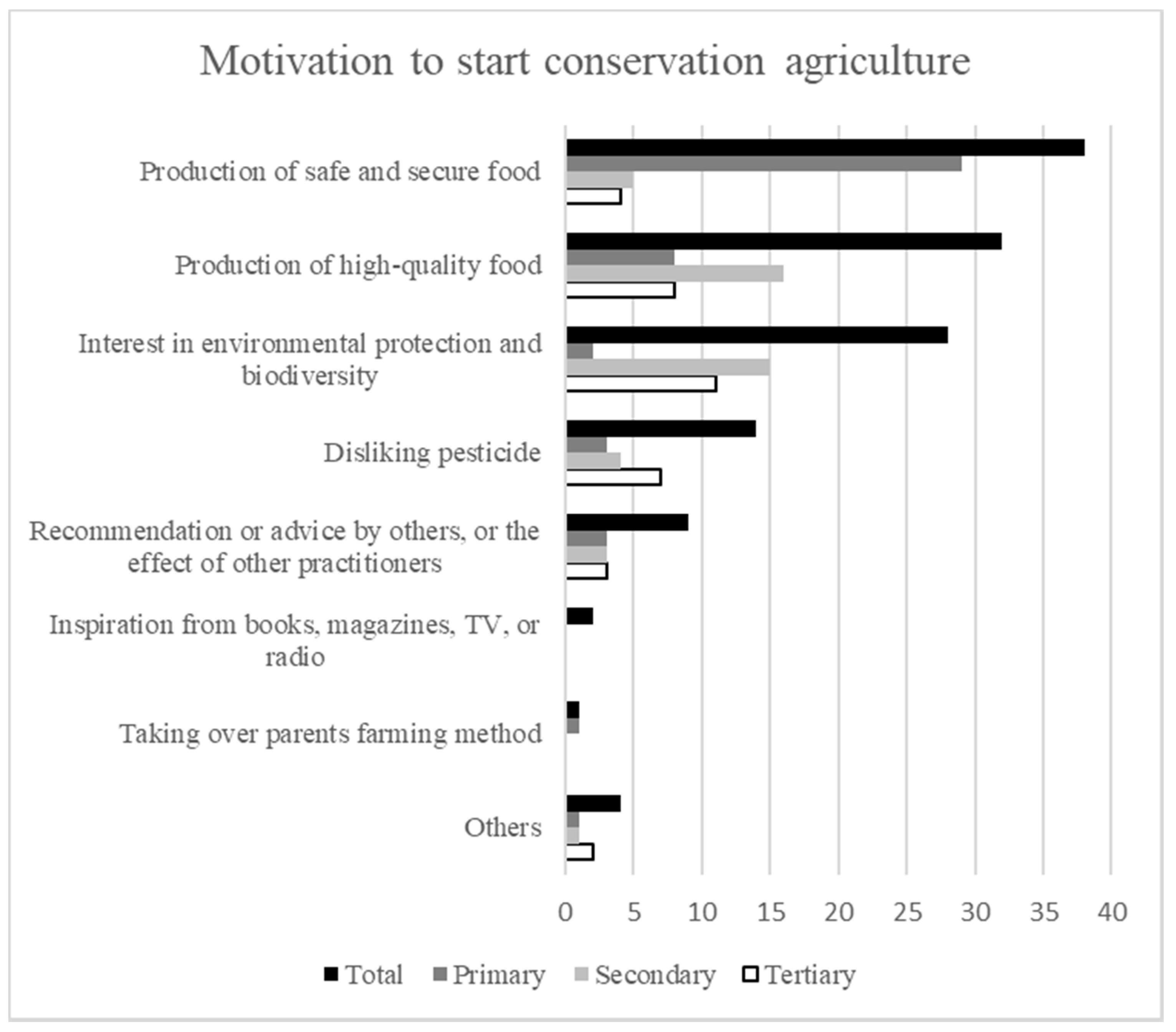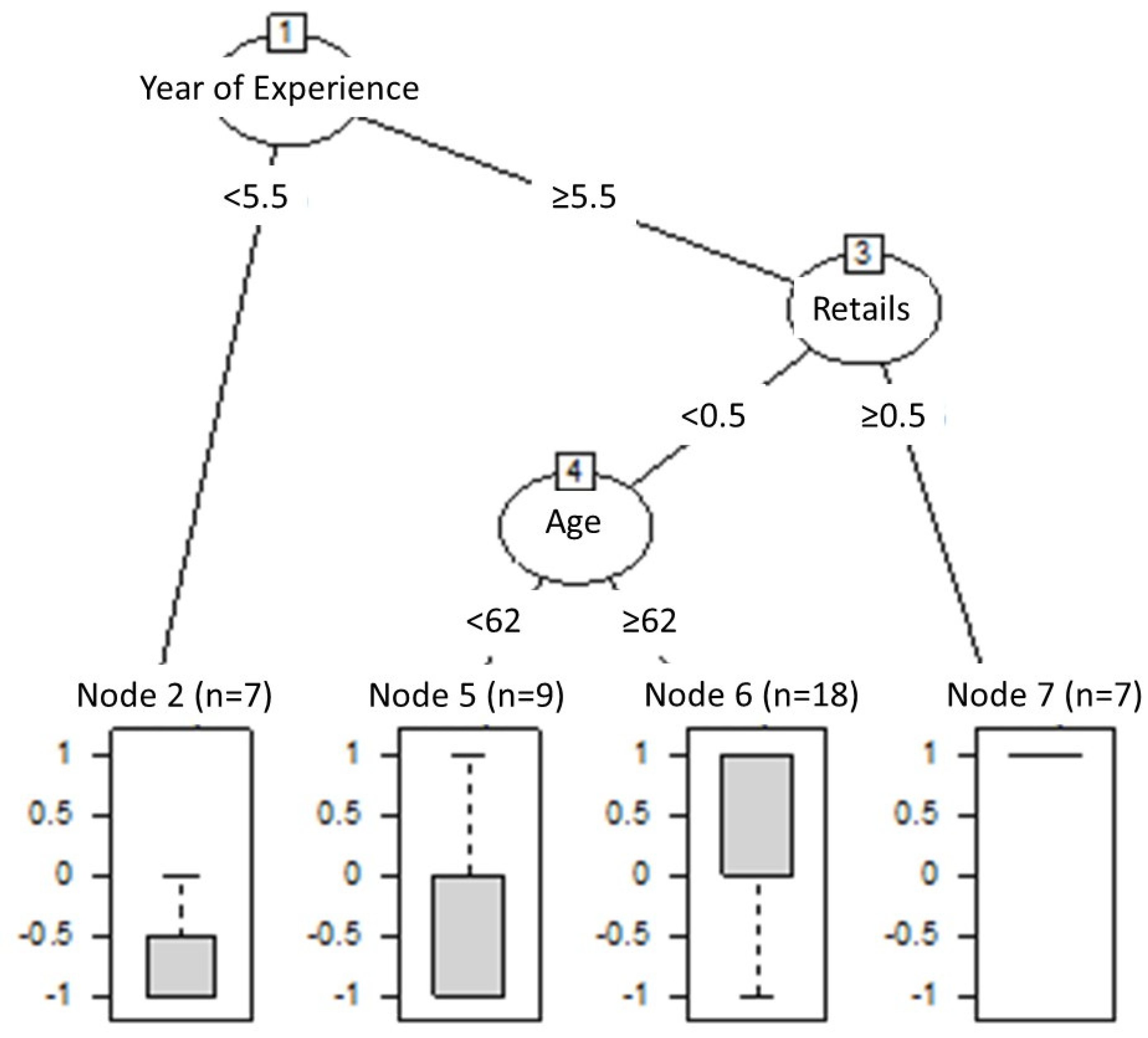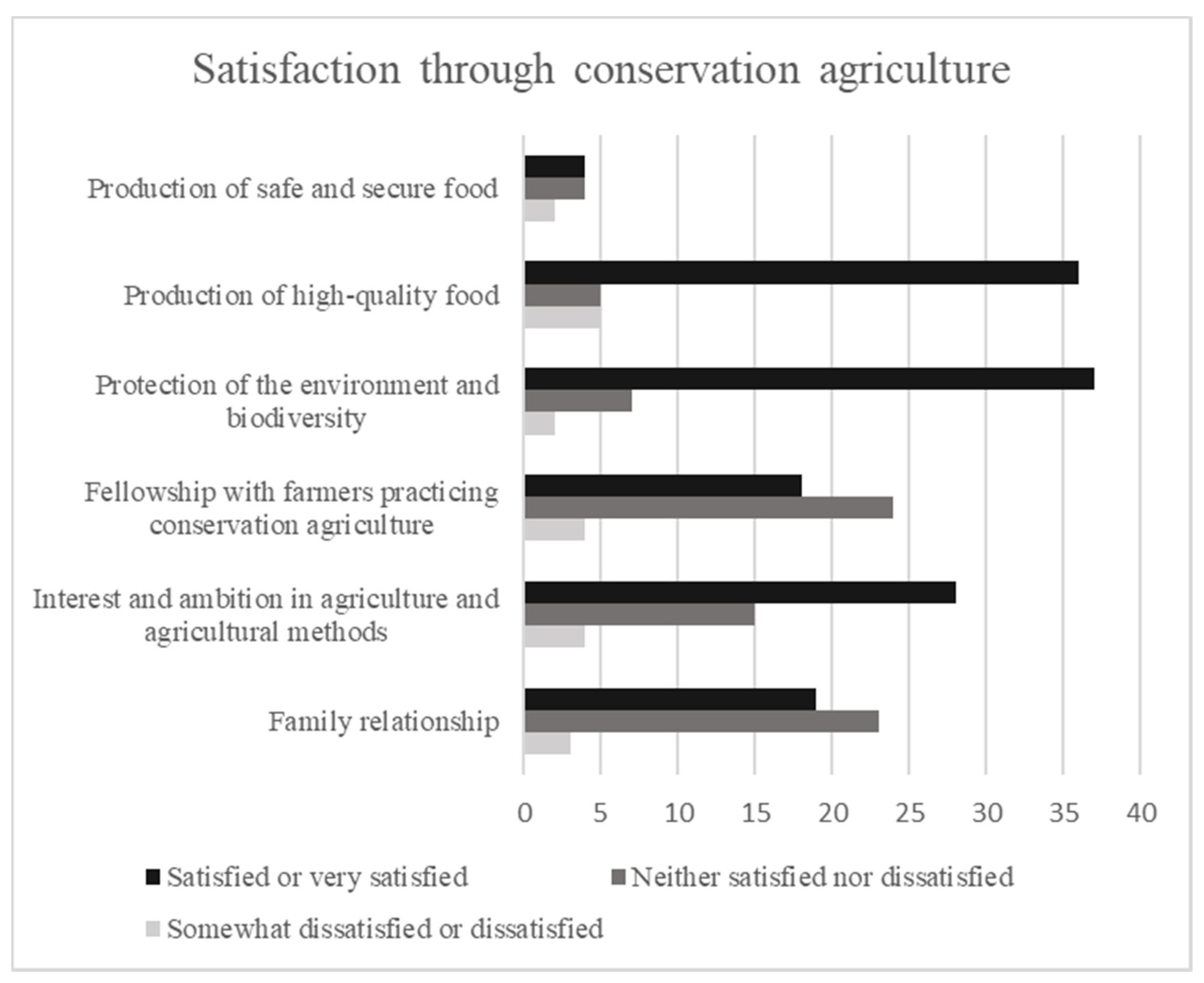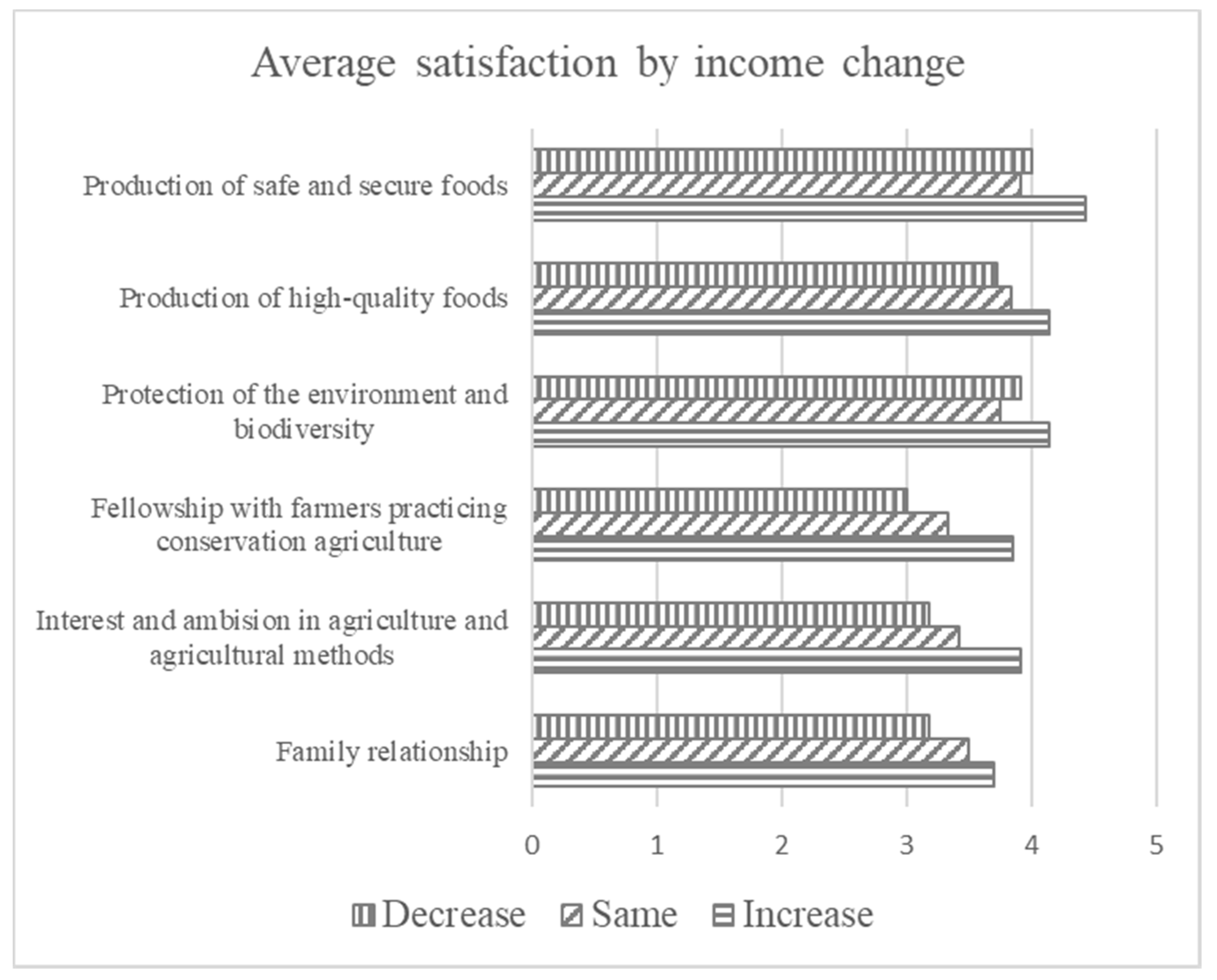Income Change and Inter-Farmer Relations through Conservation Agriculture in Ishikawa Prefecture, Japan: Empirical Analysis of Economic and Behavioral Factors
Abstract
:1. Introduction
2. Existing Studies on Farmers and Conservation Agriculture
3. Methods
3.1. Study Site and Sample Selection
3.2. Survey Questionnaire
3.2.1. Sales Channels and Income Change
3.2.2. Certification
3.2.3. Motivation to Start Conservation Agriculture
3.2.4. Satisfaction from Conservation Agriculture
3.2.5. Satisfaction with Policy at Different Times
3.3. Quantitative Analysis Methods
3.3.1. Regression Tree
3.3.2. Bonferroni Adjustment
4. Results
4.1. Characteristics of Farmers and Their Conservation Agriculture
4.1.1. Motivation to Start Conservation Agriculture
4.1.2. Sales and Sales Channels
4.1.3. Certificates
4.2. Factors That Affect Income Increase
4.3. Satisfaction from Conservation Agriculture
4.4. Satisfaction with Payment Policies
4.4.1. Multifunctional Payment
4.4.2. Direct Payment for Hilly and Mountainous Area
4.4.3. Direct Payment for Conservation-Oriented Agriculture
5. Discussion
5.1. Factors Affecting Income Change
5.2. Characteristics of Satisfaction
5.3. Relation with Satisfaction
6. Conclusions
Author Contributions
Funding
Institutional Review Board Statement
Informed Consent Statement
Data Availability Statement
Conflicts of Interest
References
- Mozzato, D.; Gatto, P.; Defrancesco, E.; Bortolini, L.; Pirotti, F.; Pisani, E.; Sartori, L. The role of factors affecting the adoption of environmentally friendly farming practices: Can geographical context and time explain the differences emerging from literature? Sustainability 2018, 10, 3101. [Google Scholar] [CrossRef] [Green Version]
- Wezel, A.; Brives, H.; Casagrande, M.; Clement, C.; Dufour, A.; Vandenbroucke, P. Agroecology territories: Places for sustainable agricultural and food systems and biodiversity conservation. Agroecol. Sustain. Food 2016, 40, 132–144. [Google Scholar] [CrossRef]
- McGranahan, D.A. Ecologies of scale: Multifunctionality connects conservation and agriculture across fields, farms, and landscapes. Land 2014, 3, 739–769. [Google Scholar] [CrossRef]
- Food and Agriculture Organization of the United Nations. Conservation Agriculture. 2022. Available online: https://www.fao.org/conservation-agriculture/en/ (accessed on 1 February 2022).
- Ministry of Agriculture, Forestry and Fisheries (MAFF). About Direct Payment for Conservation Oriented Agriculture; Ministry of Agriculture, Forestry and Fisheries: Tokyo, Japan, 2020. (In Japanese)
- Atlin, G.N.; Frey, K.J. Breeding crop varieties for low-input agriculture. Am. J. Altern. Agric. 1989, 4, 53–58. [Google Scholar] [CrossRef]
- Schaller, N. Mainstreaming low-input agriculture. J. Soil Water Conserv. 1990, 45, 9–12. [Google Scholar]
- Fess, T.L.; Kotcon, J.B.; Benedito, V.A. Crop Breeding for low input agriculture: A sustainable response to feed a growing world population. Sustainability 2011, 3, 1742–1772. [Google Scholar] [CrossRef] [Green Version]
- Liebig, M.A.; Herrick, J.E.; Archer, D.W.; Dobrowolski, J.; Duiker, S.W.; Franzluebbers, A.J.; Hendrickson, J.R.; Mitchell, R.; Mohamed, A.; Russell, J. Aligning land use with land potential: The role of integrated agriculture. Agric. Environ. Lett. 2017, 2, 170007. [Google Scholar] [CrossRef] [Green Version]
- Hendrickson, J.R.; Hanson, J.D.; Tanaka, D.; Sassenrath, G. Principles of integrated agricultural systems: Introduction to processes and definition. Renew. Agric. Food Syst. 2008, 23, 265–271. [Google Scholar] [CrossRef] [Green Version]
- European Commission. Factsheet: From Farm to Fork: Our Food, Our Health, Our Planet, Our Future; European Commission: Brussels, Belgium, 2020. [Google Scholar]
- Ministry of Agriculture, Forestry and Fisheries (MAFF). Strategy for Green Food System; Ministry of Agriculture, Forestry and Fisheries: Tokyo, Japan, 2021.
- Bouttes, M.; Darnhofer, I.; Martin, G. Converting to organic farming as a way to enhance adaptive capacity. Org. Agric. 2019, 9, 235–247. [Google Scholar] [CrossRef] [Green Version]
- Ayuya, O.I. Organic certified production systems and household income: Micro level evidence of heterogeneous treatment effects. Org. Agric. 2019, 9, 417–433. [Google Scholar] [CrossRef]
- Hansen, B.G.; Haga, H.; Lindblad, K.B. Revenue efficiency, profitability, and profitability potential on organic versus conventional dairy farms—Results from comparable groups of farms. Org. Agric. 2021, 11, 351–365. [Google Scholar] [CrossRef]
- Pham, L.; Shively, G. Profitability of organic vegetable production in northwest Vietnam: Evidence from Tan Lac District, Hoa Binh Province. Org. Agric. 2019, 9, 211–223. [Google Scholar] [CrossRef]
- Dessart, F.J.; Barreiro-Hurlé, J.; van Bavel, R. Behavioural factors affecting the adoption of sustainable farming practices: A policy-oriented review. Eur. Rev. Agric. Econ. 2019, 46, 417–471. [Google Scholar] [CrossRef] [Green Version]
- Badu-Gyan, F.; Henning, J.I.; Grové, B.; Owusu-Sekyere, E. Examining the social, physical and institutional determinants of pineapple farmers’ choice of production systems in Central Ghana. Org. Agric. 2019, 9, 315–329. [Google Scholar] [CrossRef]
- Bui, H.T.M.; Nguyen, H.T.T. Factors influencing farmers’ decision to convert to organic tea cultivation in the mountainous areas of northern Vietnam. Org. Agric. 2021, 11, 51–61. [Google Scholar] [CrossRef]
- Digal, L.N.; Placencia, S.G.P. Factors affecting the adoption of organic rice farming: The case of farmers in M’lang, North Cotabato, Philippines. Org. Agric. 2019, 9, 199–210. [Google Scholar] [CrossRef]
- Sharma, M.; Pudasaini, A. What motivates producers and consumers towards organic vegetables? A case of Nepal. Org. Agric. 2021, 11, 477–488. [Google Scholar] [CrossRef]
- Väre, M.; Mattila, T.E.A.; Rikkonen, P.; Hirvonen, M.; Rautiainen, R.H. Farmers’ perceptions of farm management practices and development plans on organic farms in Finland. Org. Agric. 2021, 11, 457–467. [Google Scholar] [CrossRef]
- Chan, C.; Sipes, B.; Ayman, A.; Zhang, X.; LaPorte, P.; Fernandes, F.; Pradhan, A.; Chan-Dentoni, J.; Roul, P. Efficiency of conservation agriculture production systems for smallholders in Rain-Fed Uplands of India: A transformative approach to food security. Land 2017, 6, 58. [Google Scholar] [CrossRef]
- Rudel, T.K.; Kwon, O.-J.; Paul, B.K.; Boval, M.; Rao, I.M.; Burbano, D.; McGroddy, M.; Lerner, A.M.; White, D.; Cuchillo, M. Do Smallholder, mixed crop-livestock livelihoods encourage sustainable agricultural practices? A meta-analysis. Land 2016, 5, 6. [Google Scholar] [CrossRef] [Green Version]
- Bartolini, F.; Vergamini, D. Understanding the spatial agglomeration of participation in agri-environmental schemes: The case of the Tuscany region. Sustainability 2019, 11, 2753. [Google Scholar] [CrossRef] [Green Version]
- Morel, K.; Léger, F. A Conceptual framework for alternative farmers’ strategic choices: The case of French organic market gardening microfarms. Agroecol. Sustain. Food 2016, 40, 466–492. [Google Scholar] [CrossRef]
- Uruma, H.; Kobayashi, R.; Nishijima, S.; Miyashita, T. Effectiveness of conservation-oriented agricultural practices on amphibians inhabiting Sado Island, Japan, with a consideration of spatial structure. Jpn. J. Conserv. Ecol. 2012, 17, 155–164. (In Japanese) [Google Scholar]
- Kanazawa, S. No-till farming as sustainable and environment-friendly farming: Crop yeild in dry field and soil characteristics. Jpn. Soc. Soil Sci. Plant Nutr. 1995, 66, 286–297. (In Japanese) [Google Scholar]
- Oda, M.; Kiminami, L. Study on the consciousness of the farm households introducing environment-friendly agriculture: Analysis based on the “certification system for the rice of living with Japanese crested ibis” in Sato City, Niigata Prefecture. Niigata Daigaku Nōgakubu Kenkyū Hōkoku 2014, 66, 85–104. (In Japanese) [Google Scholar]
- Fujita, M.; Hatano, T. Opportunity and financial status in newly started and transformed organic farmers: Based on the questionnaire surveys from organic farmers. Yūki Nōgyō Kenkyū 2017, 9, 53–63. (In Japanese) [Google Scholar]
- Uenishi, Y. Factors affecting the diffusion of conservation-oriented farming methods. J. Rural Probl. 2019, 55, 73–80. (In Japanese) [Google Scholar] [CrossRef]
- Buck, D.; Getz, C.; Guthman, J. From farm to table: The organic vegetable commodity chain of northern California. Sociol. Rural. 1997, 37, 3–20. [Google Scholar] [CrossRef]
- Guthman, J. The trouble with ‘organic lite’ in California: A rejoinder to the ‘conventionalisation’debate. Sociol. Rural. 2004, 44, 301–316. [Google Scholar] [CrossRef]
- Suzuki, Y. Sustainability and development of environmentally friendly agriculture in the hilly and mountainous farming areas—A case study of the south Aso and the mountainous region in Kyushu, Japan. Ann. Jpn. Assoc. Econ. Geogr. 1997, 43, 276–292. (In Japanese) [Google Scholar]
- Arai, S.; Nishio, M.; Yoshino, T. Connecting with Organic Farming and Living Close to a Community: Development of Yūki Hāto Netto in Shirakawa Town, Gifu Prefecture; Tsukuba Shobō: Tokyo, Japan, 2021. (In Japanese) [Google Scholar]
- Anwar, A.; Sarwar, S.; Amin, W.; Arshed, N. Agricultural practices and quality of environment: Evidence for global perspective. Environ. Sci. Pollut. Res. 2019, 26, 15617–15630. [Google Scholar] [CrossRef]
- Smith, D.L.; Almaraz, J.J. Climate change and crop production: Contributions, impacts, and adaptations. Can. J. Plant Pathol. 2004, 26, 253–266. [Google Scholar] [CrossRef]
- Oenema, O.; Wrage, N.; Velthof, G.L.; van Groenigen, J.W.; Dolfing, J.; Kuikman, P.J. Trends in global nitrous oxide emissions from animal production systems. Nutr. Cycl. Agroecosyst. 2005, 72, 51–65. [Google Scholar] [CrossRef]
- Waheed, R.; Chang, D.; Sarwar, S.; Chen, W. Forest, agriculture, renewable energy, and CO2 emission. J. Clean. Prod. 2018, 172, 4231–4238. [Google Scholar] [CrossRef]
- Mena, Y.; Gutierrez-Peña, R.; Ruiz, F.A.; Delgado-Pertíñez, M. Can dairy goat farms in mountain areas reach a satisfactory level of profitability without intensification? A case study in Andalusia (Spain). Agroecol. Sustain. Food 2017, 41, 614–634. [Google Scholar] [CrossRef]
- Ishikawa Prefectural Government. Preliminary Report of the 2020 Census; Ishikawa Prefectural Government: Kanazawa, Japan, 2021. (In Japanese)
- Ministry of Agriculture, Forestry and Fisheries (MAFF). Census of Agriculture and Forestry in Japan; Ministry of Agriculture, Forestry and Fisheries: Tokyo, Japan, 2016. (In Japanese)
- Kohsaka, R.; Tomiyoshi, M.; Matuoka, H. Tourist Perceptions of Traditional Japanese Vegetable Brands: A Quantitative Approach to Kaga Vegetable Brands and an Information Channel for Tourists at the Noto GIAHS Site. In Aquatic Biodiversity Conservation and Ecosystem Services; Nakano, S., Yahara, T., Nakashizuka, T., Eds.; Springer: Singapore, 2016; pp. 109–121. [Google Scholar]
- Kamiyama, C. Food Provisioning Services via Homegardens and Communal Sharing in Satoyama Socio-Ecological Production Landscapes on Japan’s Noto Peninsula. In Sharing Ecosystem Services; Saito, O., Ed.; Springer: Singapore, 2020; pp. 35–53. [Google Scholar]
- Kohsaka, R.; Matsuoka, H. Analysis of Japanese municipalities with Geopark, MAB, and GIAHS certification: Quantitative approach to official records with text-mining methods. SAGE Open 2015, 5, 1–10. [Google Scholar] [CrossRef] [Green Version]
- Kohsaka, R.; Ito, K.; Miyake, Y.; Uchiyama, Y. Cultural ecosystem services from the afforestation of rice terraces and farmland: Emerging services as an alternative to monoculturalization. For. Ecol. Manag. 2021, 497, 119481. [Google Scholar] [CrossRef]
- Ministry of Agriculture, Forestry and Fisheries (MAFF). About the Situation of Organic Agriculture; Ministry of Agriculture, Forestry and Fisheries: Tokyo, Japan, 2020. (In Japanese)
- Kotrlik, J.; Higgins, C. Organizational research: Determining appropriate sample size in survey research appropriate sample size in survey research. Inf. Technol. Learn. Perform. J. 2001, 19, 43. [Google Scholar]
- Quevedo, J.M.D.; Uchiyama, Y.; Lukman, K.M.; Kohsaka, R. How blue carbon ecosystems are perceived by local communities in the coral triangle: Comparative and empirical examinations in the Philippines and Indonesia. Sustainability 2021, 13, 127. [Google Scholar] [CrossRef]
- Ministry of Agriculture, Forestry and Fisheries (MAFF). A National Survey through the Network Scheme to Communicate the Information of Agriculture, Forestry, and Fisheries in the Year Heisei 27: The Survey of Awareness and Intention About Environmentally Friendly Agricultural Products Including Organic Ones; Ministry of Agriculture, Forestry and Fisheries: Tokyo, Japan, 2016. (In Japanese)
- Ministry of Agriculture, Forestry and Fisheries (MAFF). Label Guideline about Specially Cultivated Agricultural Products; Ministry of Agriculture, Forestry and Fisheries: Tokyo, Japan, 2020. (In Japanese)
- Ministry of Agriculture, Forestry and Fisheries (MAFF). Annual Report on Food, Agriculture and Rural Areas in Japan FY2019; Ministry of Agriculture, Forestry and Fisheries: Tokyo, Japan, 2020. (In Japanese)
- Ministry of Health, Labour and Welfare. HACCP, n.d. Available online: https://www.mhlw.go.jp/stf/seisakunitsuite/bunya/kenkou_iryou/shokuhin/haccp/index.html (accessed on 19 January 2021). (In Japanese).
- Japan Patent Office. Regional Collective Trademark System, n.d. Available online: https://www.jpo.go.jp/e/system/trademark/gaiyo/chidan/ (accessed on 19 January 2021). (In Japanese).
- Ito, J.; Feuer, H.N.; Kitano, S.; Asahi, H. Assessing the effectiveness of Japan’s community-based direct payment scheme for hilly and mountainous areas. Ecol. Econ. 2019, 160, 62–75. [Google Scholar] [CrossRef]
- Miyake, Y.; Kohsaka, R. Discourse of quality and place in geographical indications: Applying convention theory to Japanese tea. Food Rev. Int. 2022, 1–26. [Google Scholar] [CrossRef]
- Best, H. Organic Agriculture and the conventionalization hypothesis: A case study from west Germany. Agric. Hum. Values 2008, 25, 95–106. [Google Scholar] [CrossRef]
- Giménez Cacho, M.M.T.; Giraldo, O.F.; Aldasoro, M.; Morales, H.; Ferguson, B.G.; Rosset, P.; Khadse, A.; Campos, C. Bringing agroecology to scale: Key drivers and emblematic cases. Agroecol. Sustain. Food 2018, 42, 637–665. [Google Scholar] [CrossRef]
- Baker, B.P.; Meints, B.M.; Hayes, P.M. Organic barley producers’ desired qualities for crop improvement. Org. Agric. 2020, 10, 35–42. [Google Scholar] [CrossRef]
- Matsuzawa, T.; Kohsaka, R. Status and trends of urban beekeeping regulations: A global review. Earth 2021, 2, 933–942. [Google Scholar] [CrossRef]
- Matsuzawa, T.; Kohsaka, R. Preliminary experimental trial of effects of lattice fence installation on honey bee flight height as implications for urban beekeeping regulations. Land 2022, 11, 19. [Google Scholar] [CrossRef]
- Kohsaka, R.; Miyake, Y. The politics of quality and geographic indications for non-timber forest products: Applying convention theory beyond food contexts. J. Rural Stud. 2021, 88, 28–39. [Google Scholar] [CrossRef]
- Bliss, K.; Padel, S.; Cullen, B.; Ducottet, C.; Mullender, S.; Rasmussen, I.A.; Moeskops, B. Exchanging knowledge to improve organic arable farming: An evaluation of knowledge exchange tools with farmer groups across Europe. Org. Agric. 2019, 9, 383–398. [Google Scholar] [CrossRef]
- Chabe-Ferret, S.; Le Coent, P.; Reynaud, A.; Subervie, J.; Lepercq, D. Can we nudge farmers into saving water? Evidence from a randomised experiment. Eur. Rev. Agric. Econ. 2019, 46, 393–416. [Google Scholar] [CrossRef] [Green Version]
- Kohsaka, R.; Tomiyoshi, M.; Saito, O.; Hashimoto, S.; Mohammend, L. Interactions of knowledge systems in shiitake mushroom production: A case study on the Noto Peninsula, Japan. J. For. Res.-Jpn. 2015, 20, 453–463. [Google Scholar] [CrossRef] [Green Version]
- Miyake, Y.; Uchiyama, Y.; Kohsaka, R. Status and trends of urban organic agricultural policy in Japan: The survey on ordinance designated cities. Org. Agric. 2020, 10, 497–508. [Google Scholar] [CrossRef]
- Willer, H.; Travnicek, J.; Meier, C.; Schlatter, B. (Eds.) The World of Organic Agriculture: Statistics and Emerging Trends 2021; Research Institute of Organic Agriculture: Frick, Switzerland; Organics International: Bonn, Germany, 2021. [Google Scholar]
- Kizos, T.; Koshaka, R.; Penker, M.; Piatti, C.; Vogl, C.R.; Uchiyama, Y. The governance of geographical indications. Br. Food J. 2017, 119, 2863–2879. [Google Scholar] [CrossRef]
- Tashiro, A.; Uchiyama, Y.; Kohsaka, R. Impact of geographical indication schemes on traditional knowledge in changing agricultural landscapes: An empirical analysis from Japan. J. Rural Stud. 2019, 68, 46–53. [Google Scholar] [CrossRef]
- Miyake, Y.; Kohsaka, R. History, ethnicity, and policy analysis of organic farming in Japan: When “nature” was detached from organic. J. Ethn. Foods 2020, 7, 1–8. [Google Scholar] [CrossRef]




| Category | Item | Answer Method |
|---|---|---|
| Individual | Age | Years |
| Years of practicing conservation agriculture | Years | |
| Prospect of a successor | Multiple choice | |
| Agriculture | Five best-sold crops and the sizes of the area on which each crop is produced | Crop name and land area by hectare |
| Practices of conservation agriculture | Multiple answers possible | |
| Sales and income | Annual sales | JPY 10,000 |
| Sales channels before starting conservation agriculture | Multiple answers possible | |
| Sales channels after starting conservation agriculture | Multiple answers possible | |
| Income change with conservation agriculture on land with certification and without certification | Multiple choice | |
| Certification | Certificate type | Multiple answers possible |
| Motivation | Motivation to start conservation agriculture | List three items in order of relevance |
| Satisfaction | Satisfaction from conservation agriculture | For each item, a five-point scale ranging from very satisfied, satisfied, neither satisfied nor dissatisfied, somewhat dissatisfied, to dissatisfied |
| Policy | Satisfaction with policy at different times | For policy, a scale ranging from very satisfied to dissatisfied. Satisfaction in Year 1 and Year 4 or longer in conservation agriculture |
| (1) Reducing chemical fertilizer and chemically synthesized fertilizer to less than a half of those for conventional agriculture | 72% |
| (2) No application of herbicide over ridges between farmland plots | 46% |
| (3) No application of systematic insecticide such as neonicotinoid pesticides | 42% |
| (4) Organic certified with JAS | 34% |
| (5) Practicing a winter-flooded rice field | 24% |
| (6) Applying neither chemical fertilizer nor chemically synthesized pesticide without a JAS certificate | 22% |
| (7) Rationalizing land use of conservation agriculture in neighboring fields | 20% |
| (8) Leaving the edge of rice fields as a swale | 12% |
| (9) Creating a biotope on an uncultivated rice field | 6% |
| (10) Installing a fish waterway | 0% |
| (11) Other methods | 8% |
| Motivation | Number of Farmers | Average Scores in Corresponding Satisfaction |
|---|---|---|
| Production of safe and secure foods | 31 | 4.25 |
| Production of high-quality foods | 6 | 4.5 |
| Interest in environmental protection and biodiversity | 2 | 3 |
| Recommendation or advice by others, or the effect of other practitioners | 3 | 4 |
| Books, magazines, TV, or radio | 0 | n/a |
| Taking over parents’ agricultural method | 1 | 3 |
| Variable | Group | Mean Difference | Standard Error | p Value | 95% CI of the Difference | |
|---|---|---|---|---|---|---|
| Lower | Upper | |||||
| Level of satisfaction in fellowship with farmers practicing conservation agriculture (1–5) | Income increase | −0.857 * | 0.335 | 0.043 | −1.693 | −0.020 |
| Income decrease | ||||||
Publisher’s Note: MDPI stays neutral with regard to jurisdictional claims in published maps and institutional affiliations. |
© 2022 by the authors. Licensee MDPI, Basel, Switzerland. This article is an open access article distributed under the terms and conditions of the Creative Commons Attribution (CC BY) license (https://creativecommons.org/licenses/by/4.0/).
Share and Cite
Miyake, Y.; Kimoto, S.; Uchiyama, Y.; Kohsaka, R. Income Change and Inter-Farmer Relations through Conservation Agriculture in Ishikawa Prefecture, Japan: Empirical Analysis of Economic and Behavioral Factors. Land 2022, 11, 245. https://doi.org/10.3390/land11020245
Miyake Y, Kimoto S, Uchiyama Y, Kohsaka R. Income Change and Inter-Farmer Relations through Conservation Agriculture in Ishikawa Prefecture, Japan: Empirical Analysis of Economic and Behavioral Factors. Land. 2022; 11(2):245. https://doi.org/10.3390/land11020245
Chicago/Turabian StyleMiyake, Yoshitaka, Shota Kimoto, Yuta Uchiyama, and Ryo Kohsaka. 2022. "Income Change and Inter-Farmer Relations through Conservation Agriculture in Ishikawa Prefecture, Japan: Empirical Analysis of Economic and Behavioral Factors" Land 11, no. 2: 245. https://doi.org/10.3390/land11020245
APA StyleMiyake, Y., Kimoto, S., Uchiyama, Y., & Kohsaka, R. (2022). Income Change and Inter-Farmer Relations through Conservation Agriculture in Ishikawa Prefecture, Japan: Empirical Analysis of Economic and Behavioral Factors. Land, 11(2), 245. https://doi.org/10.3390/land11020245








